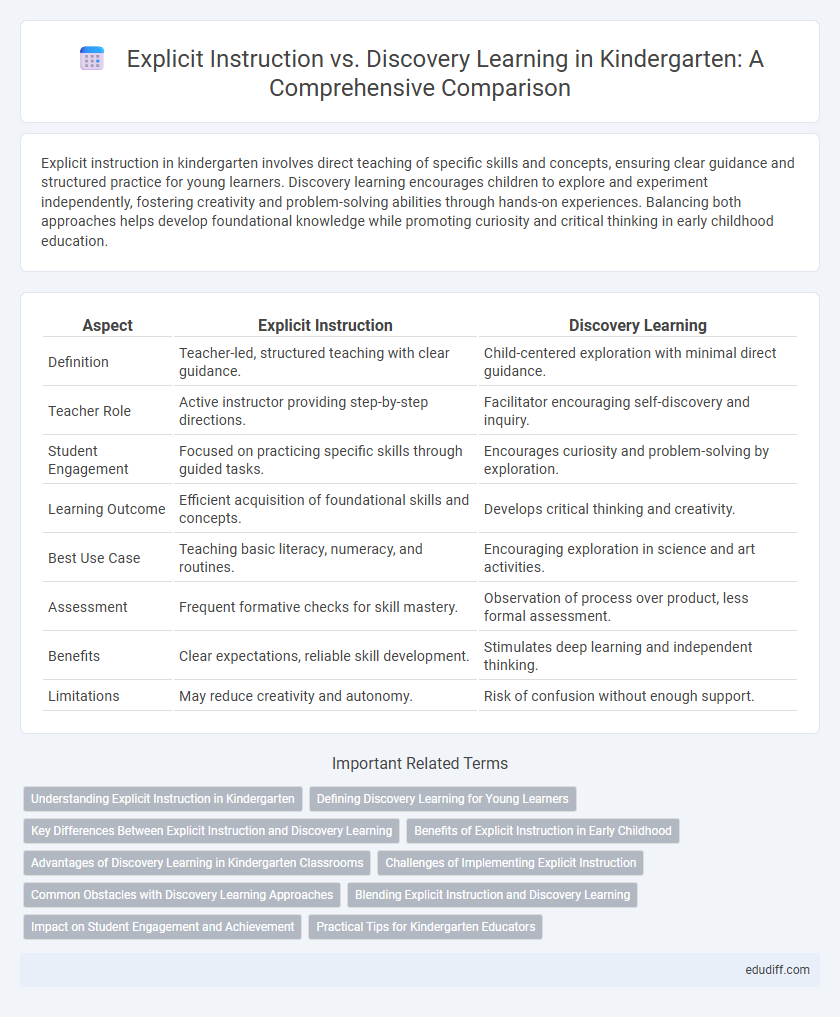Explicit instruction in kindergarten involves direct teaching of specific skills and concepts, ensuring clear guidance and structured practice for young learners. Discovery learning encourages children to explore and experiment independently, fostering creativity and problem-solving abilities through hands-on experiences. Balancing both approaches helps develop foundational knowledge while promoting curiosity and critical thinking in early childhood education.
Table of Comparison
| Aspect | Explicit Instruction | Discovery Learning |
|---|---|---|
| Definition | Teacher-led, structured teaching with clear guidance. | Child-centered exploration with minimal direct guidance. |
| Teacher Role | Active instructor providing step-by-step directions. | Facilitator encouraging self-discovery and inquiry. |
| Student Engagement | Focused on practicing specific skills through guided tasks. | Encourages curiosity and problem-solving by exploration. |
| Learning Outcome | Efficient acquisition of foundational skills and concepts. | Develops critical thinking and creativity. |
| Best Use Case | Teaching basic literacy, numeracy, and routines. | Encouraging exploration in science and art activities. |
| Assessment | Frequent formative checks for skill mastery. | Observation of process over product, less formal assessment. |
| Benefits | Clear expectations, reliable skill development. | Stimulates deep learning and independent thinking. |
| Limitations | May reduce creativity and autonomy. | Risk of confusion without enough support. |
Understanding Explicit Instruction in Kindergarten
Explicit instruction in kindergarten involves clear, structured teaching where educators provide direct explanations, modeling, and guided practice to ensure young learners grasp foundational concepts effectively. This approach supports early childhood development by minimizing confusion and maximizing skill acquisition in literacy, numeracy, and social behaviors. Research highlights that explicit instruction enhances cognitive development and academic readiness, making it essential for kindergarten curricula.
Defining Discovery Learning for Young Learners
Discovery learning for young learners emphasizes active engagement through exploration and hands-on experiences, allowing children to construct knowledge independently. This approach fosters critical thinking, creativity, and problem-solving skills by encouraging students to investigate concepts within a supportive environment. Unlike explicit instruction, discovery learning promotes curiosity and intrinsic motivation, making it especially effective for developing early cognitive and social abilities in kindergarten settings.
Key Differences Between Explicit Instruction and Discovery Learning
Explicit instruction in kindergarten involves direct teaching where teachers clearly explain concepts and provide step-by-step guidance, enhancing skill acquisition and reducing confusion. Discovery learning encourages children to explore and experiment independently, fostering creativity and critical thinking but may lead to varied learning outcomes due to less structure. The key difference lies in the level of teacher involvement: explicit instruction prioritizes structured, guided learning while discovery learning emphasizes autonomous exploration.
Benefits of Explicit Instruction in Early Childhood
Explicit instruction in early childhood education offers clear, structured guidance that enhances skill acquisition and foundational literacy development in kindergarten students. This approach supports language development and cognitive growth by providing direct teacher modeling, which reduces confusion and increases student confidence. Research indicates that explicit instruction effectively builds essential academic skills, fostering long-term educational success for young learners.
Advantages of Discovery Learning in Kindergarten Classrooms
Discovery learning in kindergarten classrooms fosters critical thinking and problem-solving skills by encouraging children to explore and experiment independently. This approach enhances creativity and engagement, allowing young learners to construct knowledge through hands-on activities and real-world experiences. By promoting curiosity and intrinsic motivation, discovery learning supports deeper understanding and long-term retention of foundational concepts.
Challenges of Implementing Explicit Instruction
Implementing explicit instruction in kindergarten faces challenges such as varying developmental readiness and limited attention spans, which can hinder young learners' ability to follow structured lessons. Teachers must balance providing clear, direct guidance while maintaining engagement through interactive and age-appropriate activities. Adapting explicit instruction to diverse learning styles requires careful planning and ongoing assessment to ensure effective knowledge acquisition.
Common Obstacles with Discovery Learning Approaches
Discovery learning in kindergarten often faces obstacles such as limited attention spans and the need for structured guidance to ensure concept comprehension. Young children may struggle with open-ended tasks due to undeveloped executive functioning skills, leading to frustration and disengagement. Without explicit instruction, foundational knowledge gaps can occur, making skill acquisition slower and less consistent.
Blending Explicit Instruction and Discovery Learning
Blending explicit instruction and discovery learning in kindergarten creates a balanced educational approach that supports both foundational skill development and creative problem-solving. Explicit instruction provides clear, structured guidance on core concepts like phonics and numeracy, ensuring children grasp essential knowledge efficiently. Discovery learning encourages exploration and critical thinking, allowing students to apply skills in meaningful contexts, fostering deeper understanding and engagement.
Impact on Student Engagement and Achievement
Explicit instruction in kindergarten promotes higher student achievement by providing clear, structured guidance and immediate feedback, which supports foundational skill development. Discovery learning encourages active engagement and curiosity by allowing children to explore concepts independently, fostering critical thinking and problem-solving abilities. Balancing both approaches can optimize cognitive development and sustain motivation, enhancing overall educational outcomes in early childhood settings.
Practical Tips for Kindergarten Educators
Kindergarten educators can enhance early childhood development by balancing explicit instruction, which offers clear, structured guidance on foundational skills such as letter recognition and basic math, with discovery learning that fosters curiosity and problem-solving through hands-on activities. Incorporating explicit instruction helps build essential knowledge efficiently, while discovery learning encourages creativity and engagement, critical for social and cognitive growth. Practical strategies include using targeted mini-lessons followed by playful exploration, integrating visual aids for clarity, and enabling small group activities to support individualized learning needs.
Explicit instruction vs Discovery learning Infographic

 edudiff.com
edudiff.com